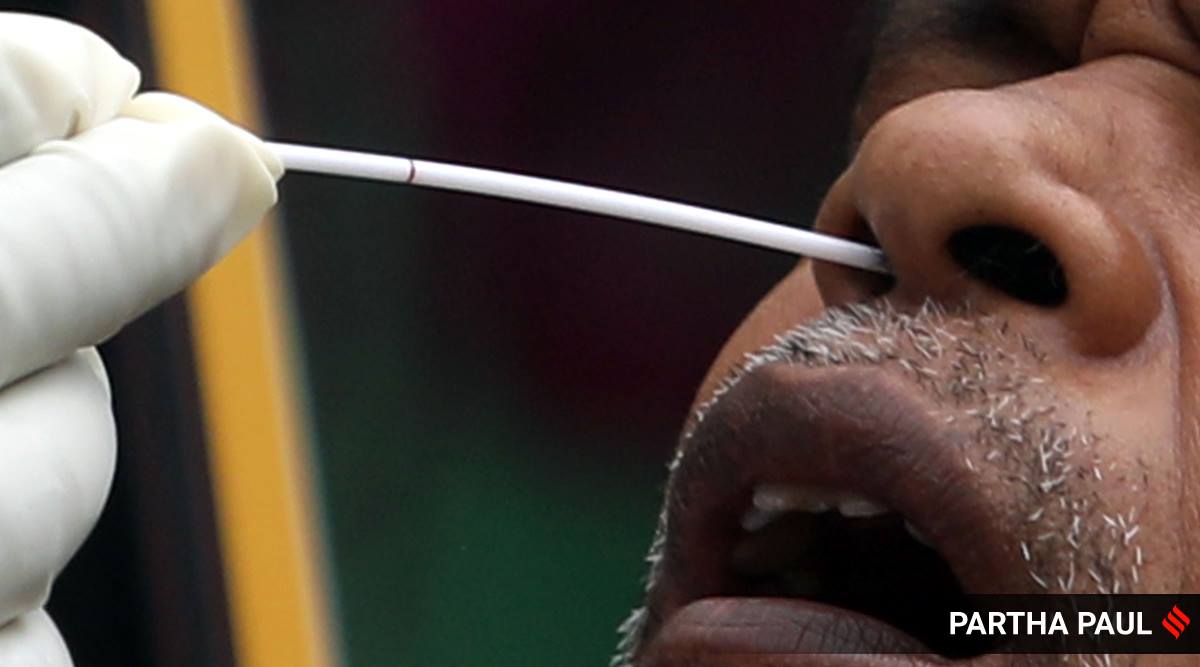 Health workers collect swab samples in Kolkata on Saturday.
Health workers collect swab samples in Kolkata on Saturday. When Sumon (name changed upon request), 23, a resident of Newtown, a satellite township near Kolkata, realised his father had symptoms of fever in July, the family hoped it would be seasonal flu, arriving with the onset of the monsoons. “The next day my mother and I developed a fever, but my father’s went away. Then my mother’s fever and mine subsided,” he said, recalling the concern and fear that followed.
Within days Sumon and his mother lost their sense of smell, causing them to frantically start searching online for coronavirus symptoms to see if this was one; it was. Then the family desperately started making phone calls to testing laboratories listed on the website of the Indian Council of Medical Research (ICMR). “They all said ‘we are not doing home testing’. ‘Call after three to four days’. Apollo Gleneagles Hospital in Salt Lake said it would take 14 to 15 days to get an appointment to get a test. AMRI Hospital said the same. Some others said testing wouldn’t be possible for an entire month,” said Sumon.
The difficulties that Sumon’s family faced with getting tested for coronavirus just scratches the surface of the multitude of challenges that patients have been facing in West Bengal. Since August, the state has been recording more than 3,000 new cases of coronavirus every day, and these are only the registered infection numbers. According to data provided by the West Bengal Department of Health and Family Welfare, till August 22, approximately 15,24,162 people have been tested in the state, with 70 registered laboratories officially enlisted for testing.

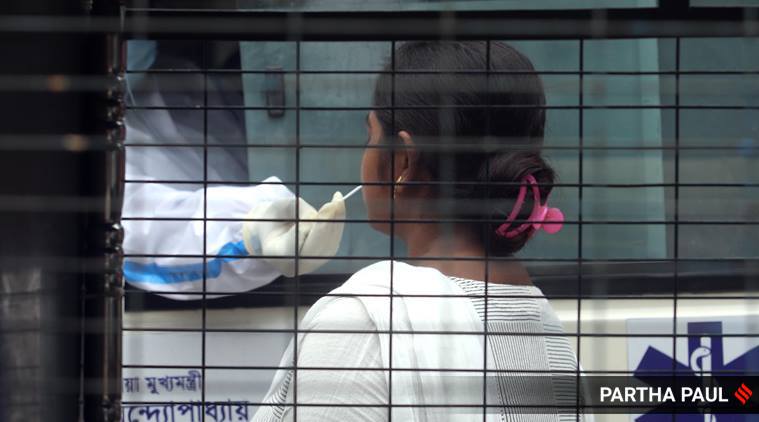 Health workers collect swab samples in Narkeldanga Main Road Kolkata on Saturday. West Bengal on August 21 had tested an all time high of 36,000 samples which is an all time high. (Express photo by Partha Paul)
Health workers collect swab samples in Narkeldanga Main Road Kolkata on Saturday. West Bengal on August 21 had tested an all time high of 36,000 samples which is an all time high. (Express photo by Partha Paul)
With all three members of his family now confined in their apartment, and days passing by without finding an available testing facility, Sumon found a centre in Kolkata, not approved by the state government, that was willing to conduct a coronavirus test for his family. The testing centre outsourced the samples to another in Hyderabad officially recognised by the ICMR. The family received their results by text message within a day and only Sumon tested positive for coronavirus. The family informed the Bidhannagar Municipal Corporation, the local civic body in charge of their neighbourhood, and went into home quarantine while their apartment building was sanitised and their neighbours were informed.
“It is so difficult to get a test here and many people are being asked to wait for at least 14 days for a time slot. But that is too long because symptoms may worsen by then. They kept telling us that the testing slots were already booked.”
Despite increasing rates of infections, the paucity of timely access to tests persists for many in the state, putting patients and their families in a state of constant anxiety. The situation is even more dire in the districts.
Subhajeet (name changed upon request), a resident of Panchla CD Block in Howrah district, faced a days-long wait to even get a COVID-19 test after developing a fever that did not subside. With approximately 12,193 infection cases recorded by the state government till August 22, Howrah has the third-highest number of coronavirus cases in the districts after the Kolkata metropolitan area and North 24 Parganas.
“Testing is severely delayed here and that can lead to a spread in infections,” he said. According to Subhajeet, at the local level in his village, testing for COVID-19 happens every few weeks and sometimes the gap can be even longer.
On an average, three to four villages share one local health centre, making testing challenging, and that is only when it even occurs. “The last testing happened on August 13 and then on August 22. There is no guarantee when testing will occur,” he added.
Chitra Das, an ASHA worker in a Howrah village, told indianexpress.com that test kits are sent to village health care centres from the West Bengal Health and Family Welfare Department every week. Tests are then sent back to Kolkata for analysis, with the exception of nasal swabs, results of which are available the same day at local hospitals themselves.
On lockdown days in the state, testing does not occur in these villages, extending the gaps between testing dates and making the wait longer for people desperate to get tested for COVID-19.
The Kulai Gramin Hospital in rural Howrah is the largest medical centre, a step above the local health centres in the villages, approximately nine kilometers from Subhajeet’s home. For people without access to their own transport, the challenges include having to turn to public modes of transportation like rickshaws, and the risk of infecting several others in the process.
“I had to wait for two to three hours to see the doctor at the Kulai Gramin Hospital. The doctor decides whether testing is required and to get the test, you have to come on another day when the testing is scheduled to take place,” Subhajeet explained, recalling the days he spent desperately trying to get tested for COVID-19.
According to Subhajeet, at this local testing centre, only 100 people are tested on one designated date. People who don’t make it to the list are asked to come back on another day when testing will happen again. Subhajeet was among those who were more fortunate. He had registered his name with a local ASHA worker, who had helped him get a slot for testing six days later. Subhajeet was finally tested on August 22 and is now waiting for his results to arrive.
Getting tested is just the beginning of people’s difficulties in the state. “My maternal uncle got COVID-19 in June in Kolkata and the family thought it was a common cold. My father, who is a doctor, recommended he get a coronavirus test. But there was denial and my relatives didn’t want to contemplate getting a test for COVID-19,” said Satyarup Siddhanta, 37, a Bangalore-based mountaineer, originally from Kolkata. “Despite my father being a doctor, we didn’t know how to take mama to get a test done and we didn’t want the car’s driver to get infected while transporting him.”
Six months after the first case of COVID-19 was recorded in West Bengal, a lack of information still abounds, as does the fear, stigma and the lack of access to medical assistance.
“In May, my friend Madhabilata faced problems with a private hospital where her mother was admitted. They didn’t want to keep a COVID-19 positive patient. She was asked to remove her mother in the middle of the night and they refused to give her an ambulance for transport. When her mother was finally transferred to Calcutta Medical College, the staff initially refused to touch her. But they later administered very good treatment,” said Siddhanta.
When Siddhanta’s uncle tested positive, he was transferred to a government hospital. “The doctors told us we had brought him in the nick of time.” Witnessing their own difficulties in navigating the complexities involving COVID-19 in West Bengal, Siddhanta and city-based model Madhabilata Mitra, decided to set up the COVID Care Network, a care-giving and consultation service in West Bengal in July.
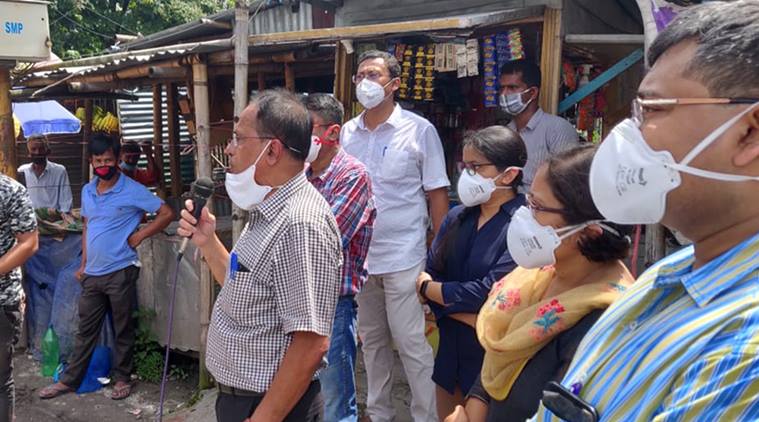 The COVID Care Network team visits a Kolkata neighbourhood to counsel residents where a COVID-19 patient was experiencing counsel social stigma and harassment. (Photo credit: Satyarup Siddhanta)
The COVID Care Network team visits a Kolkata neighbourhood to counsel residents where a COVID-19 patient was experiencing counsel social stigma and harassment. (Photo credit: Satyarup Siddhanta)
Soon, senior doctors in Kolkata and infectious diseases specialists like Dr Yogiraj Ray, who has been among the few medical health practitioners at the forefront in tackling coronavirus in the state, joined the network. The service provides phone consultations by junior doctors and medical students to residents in distress, all advised by senior doctors, to people who are unable to find the medical assistance they need, as well as mental health support. Within weeks, the service expanded to the districts of Howrah and Siliguri, which provides localised coronavirus-related information and assistance to people in those areas.
The fear of and difficulty in getting tested, along with the severe social ostracism that people are facing in the state, is also taking its toll, doctors told indianexpress.com.
“We once got an SOS call on the helpline from a Sealdah resident who was in panic. He couldn’t even open his windows or go to the terrace to dry his clothes,” recalls Siddhanta. “He wasn’t even able to go outside to get food due to the harassment. So we had to go in person and counsel the people in the neighbourhood. There was a state of panic.”
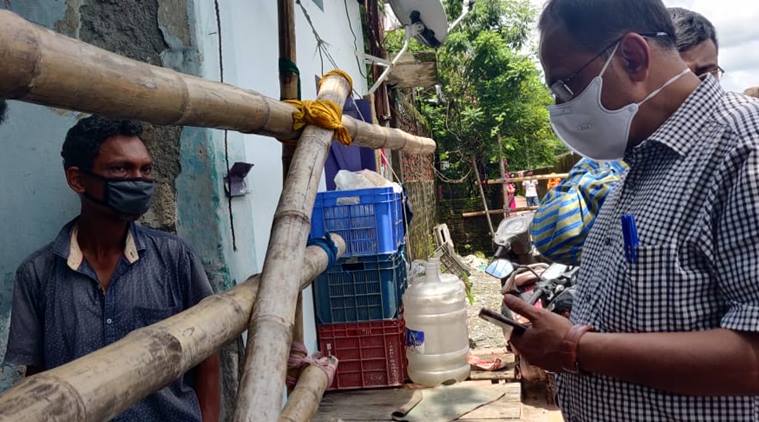 The COVID Care Network team visits a Kolkata neighbourhood to counsel residents where a COVID-19 patient was experiencing counsel social stigma and harassment. (Photo credit: Satyarup Siddhanta)
The COVID Care Network team visits a Kolkata neighbourhood to counsel residents where a COVID-19 patient was experiencing counsel social stigma and harassment. (Photo credit: Satyarup Siddhanta)
In another case in the neighbourhood of Naktala in Kolkata, when one member of a family in an apartment building got COVID-19, neighbours locked the family inside their apartment to prevent them from leaving. In desperation, the family reached out to the COVID Care Network, who urged the building residents to join a video-conference counselling call to generate more awareness of the situation. “In that call, coronavirus survivors began sharing their stories and we tried to explain that COVID-19 doesn’t mean death.”
Professor Diptendra Sarkar, a member of Kolkata’s SSKM hospital’s COVID-19 strategy team, who joined the COVID Care Network to provide his expertise and assistance, believes the psychological impact of the disease hasn’t been highlighted enough amid the focus on issues such as difficulties in getting tested or getting a hospital bed or getting an ambulance for patients.
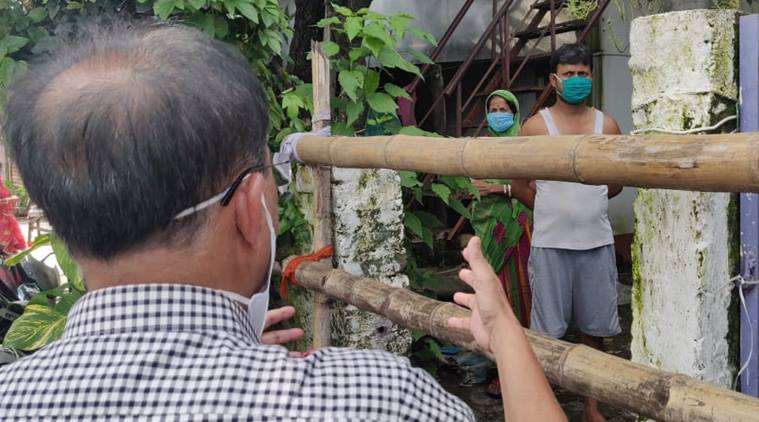 The COVID Care Network team visits a Kolkata neighbourhood to counsel residents where a COVID-19 patient was experiencing counsel social stigma and harassment. (Photo credit: Satyarup Siddhanta)
The COVID Care Network team visits a Kolkata neighbourhood to counsel residents where a COVID-19 patient was experiencing counsel social stigma and harassment. (Photo credit: Satyarup Siddhanta)
“Everybody is forgetting the third pillar of pandemic management which is community management. People can’t see the virus, but the infected person has become representative of the virus,” explained Professor Sarkar. “So there may not be physical lynching, but the psychological lynching has been there. The stigma causes guilt and patients are excommunicated and made to feel they don’t have the right to live.”
In July, videos from West Bengal’s Bongao went viral that showed a 68-year-old suspected COVID-19 patient’s wife struggling alone to move him into a waiting ambulance. Bystanders, including a medical worker in PPE gear standing nearby stood watching, providing no assistance to the crying woman, presumably out of fear of getting infected. According to reports, 30 minutes later, the patient was dead.
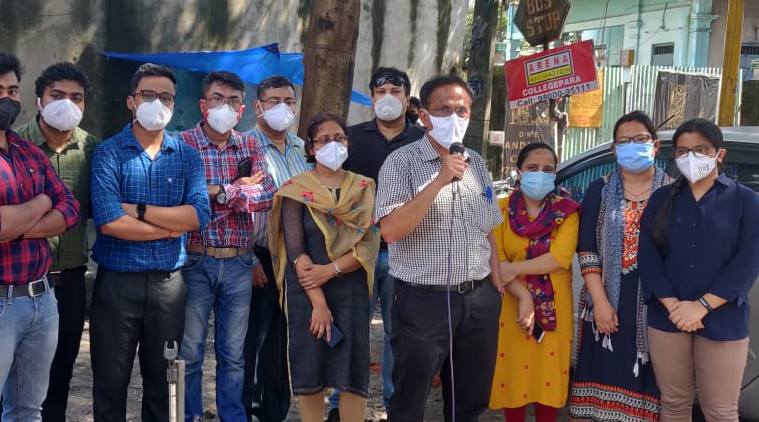 The COVID Care Network team during a visit to a Kolkata neighbourhood during a community counselling session. (Photo credit: Satyarup Siddhanta)
The COVID Care Network team during a visit to a Kolkata neighbourhood during a community counselling session. (Photo credit: Satyarup Siddhanta)
Dr Abhijit Chowdhury, a member of the state task force in tackling COVID-19, and a member of the COVID Care Network, emphasised that more than half the fight against coronavirus happens outside the hospital where issues such as the spread of unscientific information and stigma are addressed. “Top down, the imposition of action and information has been rigid rules and fear. The problem with non-participation of people is that it prevents us from dealing with this as a public health crisis,” said Dr. Chowdhury. “About 85 to 90 per cent of COVID-19 cases can be managed at home, but tremendous fear and stigma has occurred over the past few months.”